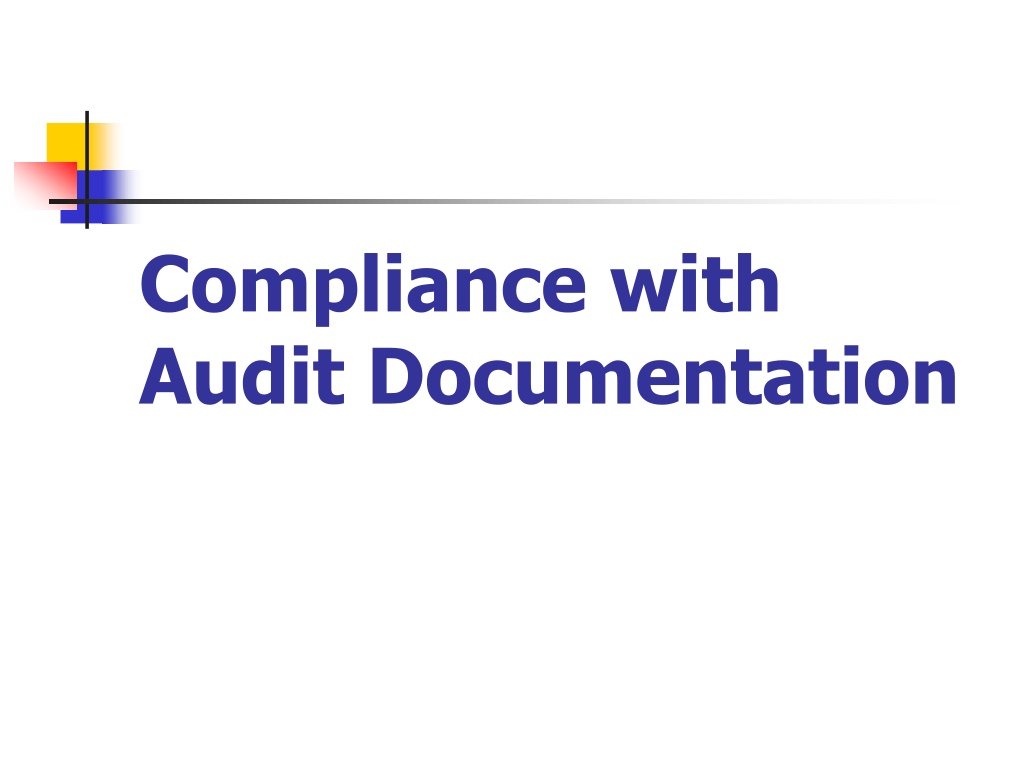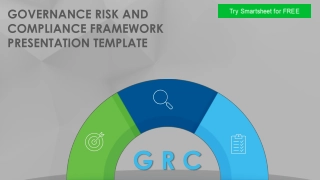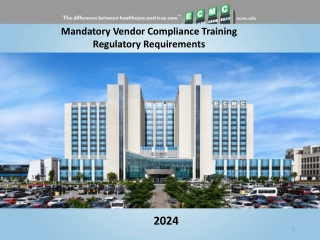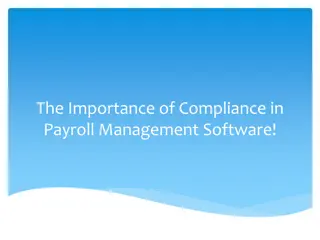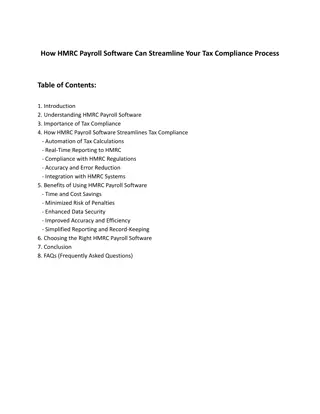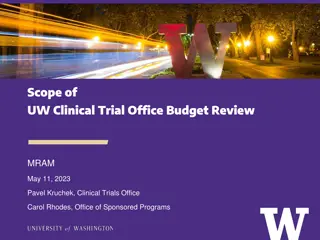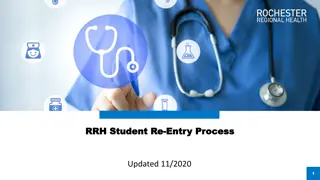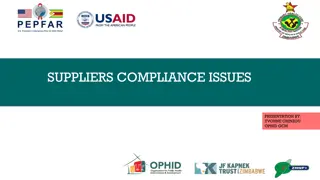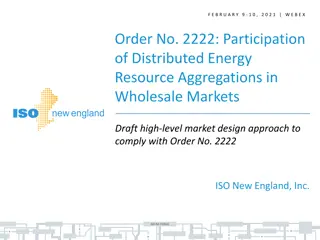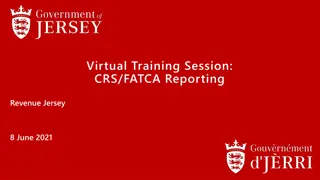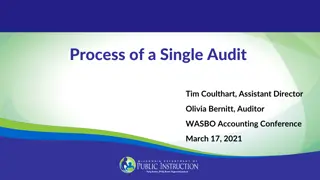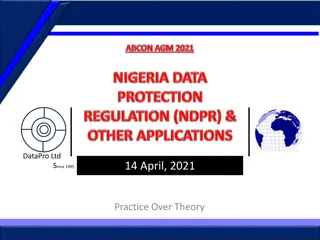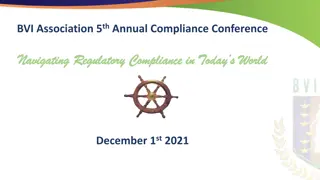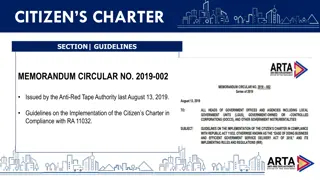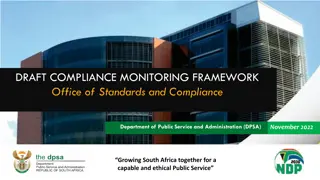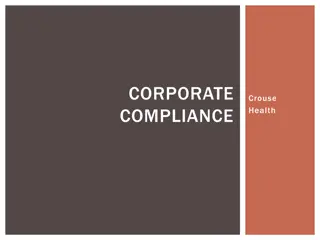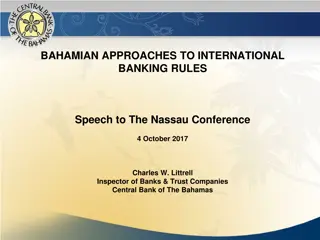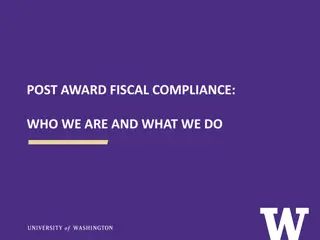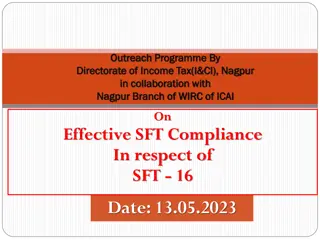Compliance with Audit Documentation
Understand the significance of audit documentation in proving compliance with audit requirements, ensuring quality audit work, and providing evidence for audit conclusions. Learn about the purpose, requirements, and definitions of audit documentation as outlined in auditing standards. Proper documentation is crucial for substantiating the auditor's diligence and adherence to legal and regulatory requirements.
Download Presentation

Please find below an Image/Link to download the presentation.
The content on the website is provided AS IS for your information and personal use only. It may not be sold, licensed, or shared on other websites without obtaining consent from the author. Download presentation by click this link. If you encounter any issues during the download, it is possible that the publisher has removed the file from their server.
E N D
Presentation Transcript
Compliance with Audit Documentation
Agenda Understand audit documentation So that we can prove that we have complied with the requirements in our audit and assurance assignments.
Scope Para of Auditors Report We conducted our audit in accordance with the auditing standards generally accepted in India. These standards require that we plan and perform the audit to obtain reasonable assurance whether the financial statements are free of material statement. An audit includes examining, on a test basis, evidence supporting the amounts and disclosures in the financial statements. An audit also includes assessing the accounting principles used and significant estimates made by management, as well as evaluating the overall financial statement presentation. We believe that our audit provides a reasonable basis for our opinion.
Importance of Documentation With the quality of audit work getting increasingly questioned, documentation is the only way for an auditor to substantiate that he was not negligent.
What is documentation? In common parlance documentation refers to the working papers prepared or obtained by the auditor and retained by him, in connection with the performance of his audit.
Requirements of Audit Documentation As per SA-230 Audit Documentation (revised), Specific requirements of other SAs and Additional documentation requirements under specific laws or regulations.
Documentation SA 230 (Revised) Purpose of Audit Documentation Provides evidence of the auditors basis for a conclusion about the overall objective of the audit. Provides evidence that the audit was planned and perform in accordance with SAs and applicable legal and regulatory requirements. Enables the conduct of quality control reviews and inspections in accordance with SQC 1.
Documentation SA 230 (Revised) Audit Documentation- definition It is the records of audit procedures performed, Relevant audit evidence obtained and Conclusions the auditor reached Prepared on timely basis. Should enable an experienced auditor, having no connection with the audit , to understand: audit procedure performed, results of the audit procedures performed and the audit evidence obtained and significant judgments made in reaching the conclusion.
Documentation of audit procedure performed The auditor to record: The identifying characteristics of the specific items of matter tested. Who performed the audit work and the date such was completed. Who reviewed the audit work performed and the date and extent of such review.
Documentation of audit procedure performed The auditor to document: Discussions of the significant matters with the management, those charged with the governance and others. The nature and significant matters discussed. When and with whom discussions took place. If some information is identified that is inconsistent with the auditor's conclusion, how that was addressed.
Assembly of the final audit file The auditor to assemble the documentation in an audit file on timely basis after the date of the auditors report. Once the assembly is complete, not to delete or discard audit documentation. If circumstances so required, some new audit documentation is added after the assembly of the audit file, the auditor to document the specific reasons for making them and to record when and by whom they were made and reviewed.
Broad Requirements of audit documentation Recording of the audit plan. Nature, timing and extent of audit procedures performed. Conclusions drawn from the evidence obtained. May be recorded on paper or on electronic or other media
Factors Affecting Form, content and extent of audit documentation Nature of engagement Form of audit report Nature/complexity of client s business Nature/condition of client s records Degree of reliance on internal controls Need for direction, supervision and review of work done by assistants.
Principal requirements of audit documentation Design tailored to circumstances and needs of each engagement Standardised (checklists, specimen letters) Sufficiently complete and detailed for the auditor to obtain overall understanding Significant matters requiring exercise of audit judgement must be included, along with auditor s conclusions Audit procedures applied/documented on client prepared schedules.
Quality of audit documentation Working papers to have adequate audit evidence for assertions made in financial statements Working papers to agree with books of account, financials and are cross referenced Complete lead schedules Audit summary memorandum Evidence of Review of assistants work
Examples of audit documentation of compliance with SAs Audit plan demonstrates that auditor has planned the audit. Signed engagement letter demonstrates the auditor has agreed the terms of engagement with management. Qualified opinion demonstrates that the auditor has complied with the reporting requirement.
Documentation requirements- SQC 1 To provide evidence of the operation of each of the following elements of its system of quality control: Leadership responsibilities for quality within the firm Ethical requirements Acceptance and continuance of client relationships and specific engagements Human resources Engagement performance and Monitoring
Documentation requirements-SA-210 Terms of Audit Engagements Copies of engagement letters. Request from client for change in Engagement, if any. Copy of revised engagement letter, if any. Agreeing the Terms of Audit Engagements SA-210 (Revised) (for audit of financial statements for periods beginning on or after 1.4.2010) Agreement of management of its responsibilities.
Documentation requirements-SA-220 Quality Control for Audit Work Communicationof Firms general quality control policies and procedures to its personnel. Direction- communication to assistants what they have to do. Supervision- resolving differences of professional judgement. Review: Documentation of the audit evidence obtained from substantive procedures and the conclusions drawn there from, including the results of consultations. Quality control for an Audit of Financial Statements (SA-220 Revised) (for audit of financial statements for periods beginning on or after 1.4.2010)
Documentation requirements-SA-240 (Revised) The Auditor s Responsibility to Consider Fraud and Error in an Audit of Financial Statements Management s communication to those charged with governance regarding its processes for identifying and responding to the risk of fraud. Management communication to employees regarding its views on business practices and ethical behaviour. Management Representations from management and those who are charged with governance about their responsibility to design, implement and maintenance of internal control tp prevent and detect fraud, results of their assessment of risk and disclosure af fraud or suspected fraud affecting the entity.
Documentation requirements-SA-250 (Revised) Consideration of Laws and Regulations in an Audit of Financial Statements Representation from management that known non- compliances have been reported to the auditors. Auditor to document identified or suspected non- compliance with law or regulations, communication to the management and results of discussion with them. Reporting of non-compliance to Regulatory and enforcement authorities.
Documentation requirements- SA- 260 (Revised) Communication with Those Charged with Governance Matters to be communicated in terms of Paras 10,11,12 and 13. If communicated orally, the auditor to document them as to when and to whom communicated. Communicating Deficiencies in Internal Control to those charged with Governance and Management SA 265 (for audit of financial statements for periods beginning on or after 1.4.2010)
Documentation requirements-SA-299 Joint Audit of Financial Statements The division of work among joint auditors as well as the areas of work to be covered by all of them should be adequately documented and preferably communicated to the entity (Para3).
Documentation requirements-SA-300 (Revised) Planning an Audit of Financial Statements The auditor should document his overall plan. The form and the extent of the documentation will vary depending on the size and complexity of the audit .
Documentation requirements-SA-315 Identifying and Assessing the Risks of Material Misstatement Trough Understanding the Entity and its Environment (i) The auditor should document in the audit working papers: (a) the understanding obtained of the entity s accounting and internal control systems; and (b) the assessment of control risk. (ii) When control risk is assessed at less than high, the auditor would also document the basis for the conclusions (Para 26).
Documentation requirements-SA-501 Audit Evidence- Additional Considerations for Specific Items The auditor to obtain a written representation from management concerning the completeness of information provided regarding and assurance with regard to adherence to laid down procedures the inventory and physical inventory count. litigation and claims, estimates of financial implications, including costs etc. Valuation and disclosure of long term investments Segment information Audit Evidence- Specific Considerations for Specific Items SA-501 (Revised) (for audit of financial statements for periods beginning on or after 1.4.2010)
Documentation requirements-SA-540 (Revised) Auditing Accounting Estimates including Fair Value Accounting Estimates and Related Disclosures Written representation from management and where appropriate from those charged with governance, whether the management believes significant assumptions used in making accounting estimated are reasonable. (Para 22). The audit documentation shall include the basis for the auditors conclusions about the reasonableness of accounting estimates and their disclosure that give rise to significant risks and indicators of possible management bias, if any. (Para 23).
Documentation requirements-SA-550 Related Parties Written representations (Para 26) The auditor shall include in the audit documentation, the names of the identified related parties and the nature of the related party relationships. Related Parties SA-550 (Revised) (for audit of financial statements for periods beginning on or after 1.4.2010)
Documentation requirements-SA-560 (Revised) Subsequent Events Written representations from the management to provide in writing that all events occurring subsequent to the date of the financial statements and for which the applicable financial reporting framework requires adjustment or disclosure have been adjusted or disclosed. (Para 9)
Documentation requirements-SA-600 Using the work of Another Auditor (a) The principal auditor should document in his working papers the components whose financial information was audited by other auditors; their significance to the financial information of the entity as a whole; the names of the other auditors; and any conclusions reached that individual components are not material. (b) Document the procedures performed and the conclusions reached. For example, the auditor would document the results of discussions with the other auditor and review of the written summary of the other auditor s procedures. (c) The principal auditor need not document the reasons for limiting the procedures in the circumstances, provided those reasons are summarized elsewhere in the documentation maintained by the principal auditor. (d) Where the other auditor s report is other than unmodified, the principal auditor should also document how he has dealt with the qualifications or adverse remarks contained in the other auditor s report in framing his own report.
Documentation requirements SA-610 Using the work of Internal Auditor The documentation by external auditor s general as well as specific evaluation of the internal audit function and conclusions in this respect (Para 10 and 13). Using the Work of Internal Auditors SA-610 (Revised) (for audit of financial statements for periods beginning on or after 1.4.2010)
Documentation requirements SA-620 (Revised) for audit of financial statements for periods beginning on or after 1.4.2010 Agreement in writing with the expert: as to the nature, scope and objectives of his work Respective roles and responsibilities Nature time and extent of communication between the two Confirmation from expert regarding observation of confidentiality of information.
Classification of audit documentation In the case of recurring audits: Permanent audit files- updated yr to yr Current audit files- year specific.
Mandatory Permanent File Contents Information about legal/organisational structure Extracts of legal documents, agreements, minutes Record of study/evaluation of internal controls Past audited financial statements Analysis of significant ratios/trends Copies of management letters Record of communication with the retiring auditor Notes regarding significant accounting policies Significant past audit observations
Mandatory Current Files Contents 1 Acceptance of appointment letters Minute book extracts Evidence of planning process and audit program Analysis of transactions and balances Record of nature, timing and extent of audit work performed & results thereof Evidence of supervision of assistants work Continued..
Mandatory Current File Contents 2 Communication with other auditors, experts and third parties Letters of representation/confirmation received from management Conclusions about significant audit issues, including how exceptions/unusual matters were resolved/treated Copies of financial information under report and related audit reports
Recommendatory Records Profile of Firm List of clients Staff files Manual of policies and procedures for : - Acceptance of engagement -Skill and competence required -Manner of assignment/delegation of authority and responsibility -Consultation procedure -Client retention policy -Engagement monitoring guidelines -Direction/supervision policies
Documentation- impact of size of PU Small Size PUs may find some of the documentation too elaborate for most of their clients and so should tailor their audit documentation to suit the particular circumstances but with justification for doing so.
Word of caution Mere maintenance of adequate documentation does not, by itself, imply that quality control policies/procedures of the PU are adequate.
